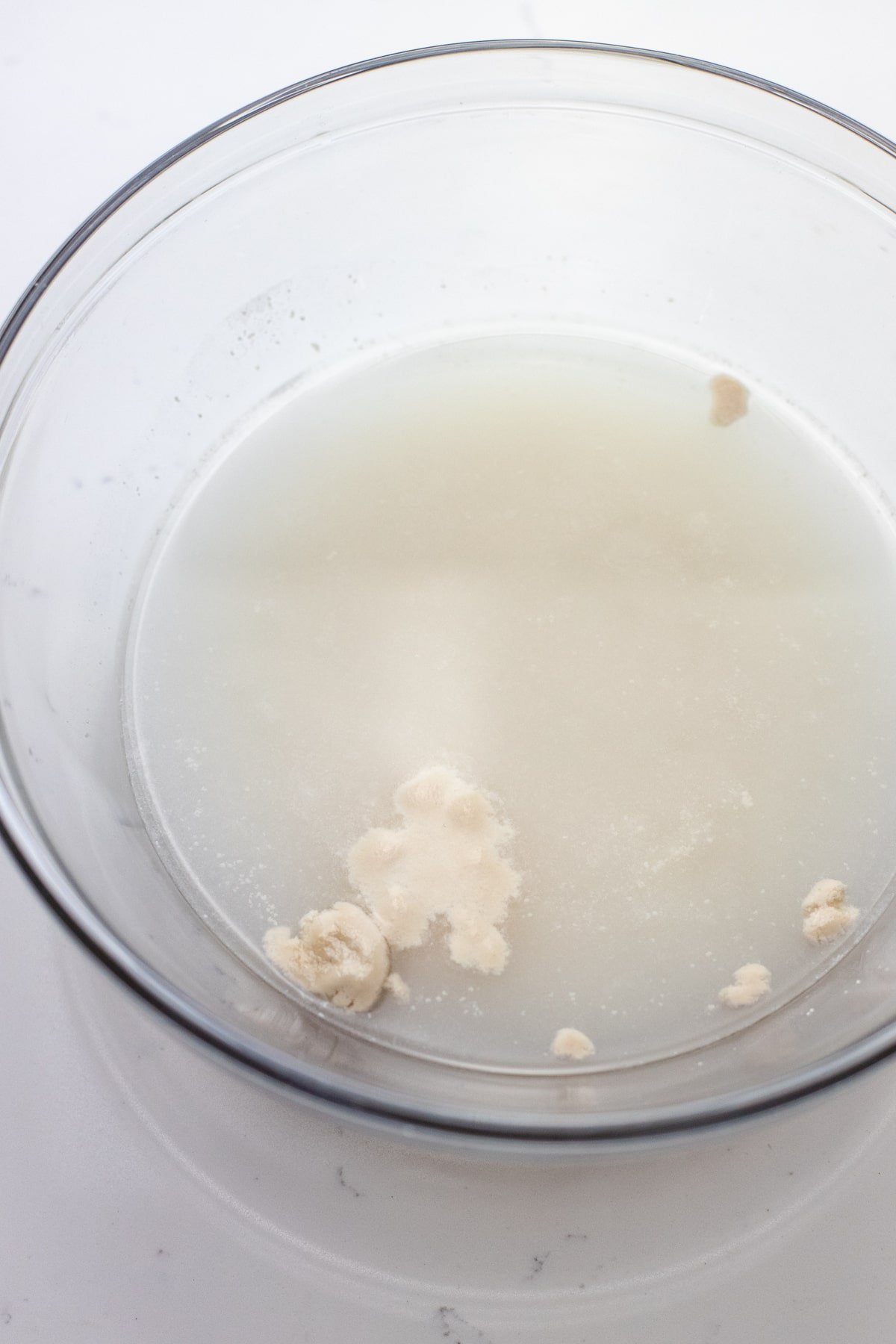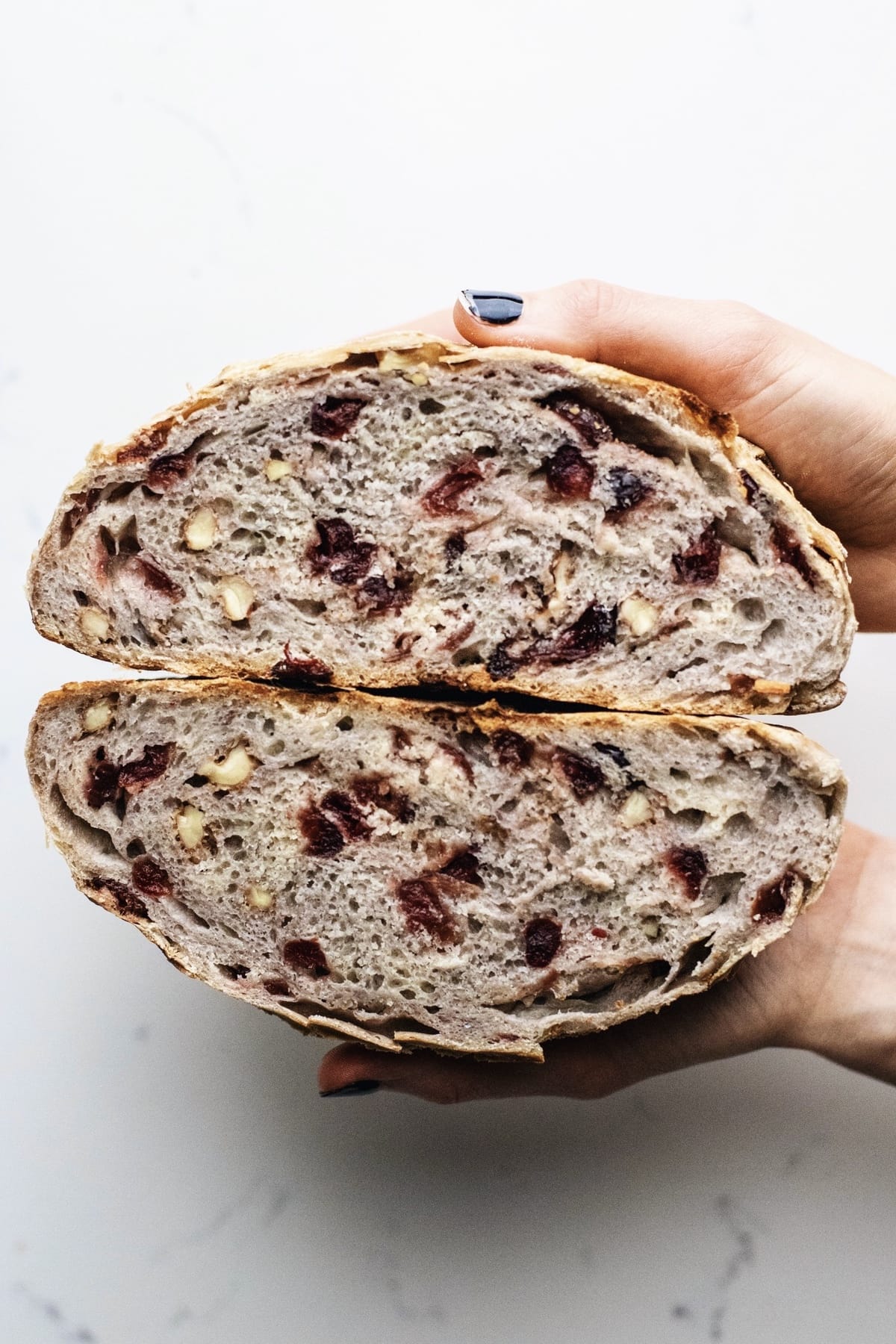Homemade cranberry walnut bread with the crunchiest crust, doughy inside, and requires no kneading at all (hoorah!). A delicious bread to compliment any meal that is perfection when toasted!

Homemade bread is the perfect baking activity, and lucky for us, it’s quite easy to do (especially when no kneading is needed). You’ll love the flavor of this sweet and nutty bread! Allowing the dough to rise for a period of time is key to attain that PERFECT crusty top and doughy center.
We also bake this bread in a dutch oven to trap as much heat as possible. This is where that crusty texture is developed. It’s such an easy bread recipe! So if you’re new to baking bread, this is pretty much “fool proof”.
This specific recipe was inspired by our beloved dutch oven cinnamon raisin bread that so many readers have enjoyed! We hope you love this bread just as much. <3 Carb lovers unite.
Ingredients – What You’ll Need
- yeast: instant yeast or dry active both work in this recipe. Below we explain different steps you’ll need to take when using one or the other for homemade bread.
- flour: I used all purpose flour for this specific recipe.
- sugar: my favorite sugar to bake with is coconut sugar because it’s a natural unrefined sweetener. If you do not have access to this sugar you can swap for brown or white sugar.
- cranberries: I recommend unsweetened dried cranberries.
- walnuts: You can also swap for pecans too! But we love the crunch and thickness of walnuts better.
How to Make Cranberry Walnut Bread (no kneading required)
- activate the yeast with warm water (skip this step if using instant yeast).
- stir in rest of ingredients until combined. Dough should be slightly sticky but not too much.




- Don’t touch the dough too much, just roll it out from one bowl to a large greased bowl.
- Cover with plastic wrap and let dough rise for 10-12 hours.



- Use floured hands to form dough into a ball on a floured surface (try not to handle it too much). I like to tuck the peaces underneath the bottom until the top smooths out a bit.
- Line dutch oven or pot with parchment paper and place dough in center – sprinkle bottom of paper with flour so bread doesn’t stick. Cover and bake for 30 minutes, then remove lid and bake for 10 minutes uncovered until golden brown.
Using Different Types of Yeast
Active dry yeast: You’ll need to take different steps when baking bread with different yeasts. If you have active dry yeast on hand, you will need to activate it in water before adding flour (this step is included in the instructions).
Instant yeast: If you have instant yeast, you can skip dissolving it in water and stir it into your dry ingredients before adding water. Instant yeast has super small granules compared to active dry yeast so it does not need to be activated in water first.

Tips for Bread Making
Every oven is different: keep this in mind when baking bread. Some ovens can get much hotter than others and cause the bake to happen much faster. Check on the color of your bread in the last 15 minutes – pull when it’s golden brown on top.
Flour the bottom of the parchment paper: Don’t forget after lining the pot with parchment paper to sprinkle a little flour on the bottom so the dough doesn’t stick.
Keep your proofing temperature consistent: when the dough is “proofing” or rising, make sure the temperature of the room is consistent. You don’t want it to be too hot or too cold. I like to put the dough in the oven (settings OFF) and place the oven light on. It’s a climate controlled area and the light creates a small amount of warmth that will encourage the dough to rise.
Why Using a Dutch Oven is Best
Dutch oven pots are made of heavy cast iron that radiate a lot more heat than a typical bread pan. It’s an excellent way to trap moisture with the bread and create a crunchy crust through the high heat!
Storing & Freezing Tips
Keep leftovers fresh by storing in a ziplock bag in refrigerator and heat in oven or toast when ready to enjoy.
Freeze bread by storing in a freezer-friendly bag for up to 2 months. Remove, thaw, and reheat at 350 until warm in oven.

Our Favorite Way to Serve It
This bread is beautiful served alongside any hearty meal or for soup dipping. We also love toasting it and spreading with butter and a drizzle of honey! So so good.
We hope you love this bread just as much as we do! The crust is so crispy, crunchy, with a beautiful doughy inside with all the best textures and sweet flavor.
Happy baking!
No Knead Cranberry Walnut Bread
Ingredients
- 3 1/4 cups (430 grams) all-purpose flour (plus more for handling)
- 1 1/2 cups (360 ml) warm water
- 1/2 teaspoon active dry yeast (see notes)
- 2 Tablespoon sugar (coconut sugar or brown sugar)
- 1 teaspoon salt
- 1/2 (heaping) cup dried cranberries
- 1/2 (heaping) cup walnuts (chopped)
Instructions
- Activate yeast: in a large bowl, mix together warm water (110F) with sugar and yeast. Let sit for 10 minutes. Note: sugar feeds yeast so it is great to include in this step.
- Mix rest of ingredients: add to yeast mixture – flour, salt, dried cranberries, and walnuts. Mix until ingredients have fully combined.
- Let dough rise: Lightly grease a separate bowl. Transfer dough into greased bowl, cover with plastic wrap and let rise for 10+ hours. Tip: it's best to keep dough in a temperature controlled environment that isn't too warm or too cold.
- Preheat oven to 450F.
- Form dough: Lightly dust hands with flour and place dough onto a lightly floured surface. Without over-handling dough, form into ball – tuck edges underneath bottom to create a smooth top.
- Transfer dough: Line dutch oven with sheet of parchment paper. Lightly dust the bottom of the paper with flour to prevent the dough from sticking. And carefully transfer dough to pot.
- Bake: Cover with lid and bake for 30 minutes then uncover and bake additional 10 minutes. Note: Every oven is different, keep an eye on the bread the last 10 minutes. When it's golden brown pull from oven.
- Let bread cool: Remove pot from oven, carefully use paper edges to lift the bread from the pot and let it cool for 20-30 minutes before slicing into.




Is this dough suppose to be so wet?
I don’t see other people asking this, but mine was SO wet when I mixed it initially it was more like batter than dough. I added so flour and hoped for the best. When I took it out from rising to make the loaf, i could hardly handle it, still so wet and batter-like. So I dumped it in the pot and hoped for the best. It’s almost done with the indicated baking time, and it doesn’t look hopeful.
Love this recipe! I’ve made it going on 3 times including the one that’s proof now. Have you ever tried baking this bread in a cast iron fry pan or on a baking sheet? If so what temperature did you use. Thanks for such an amazing recipe.
I’m so glad to hear it! Thank you Donna! I’ve not tried it in any other baking vessel. My only other thought would be a stainless steal pot with a lid. You would definitely need to keep the heat trapped in whatever baking vessel you use so the moisture can give the bread the perfect crust!
This was wonderful and made a great Christmas gift!!
Such a great idea as a Christmas gift. Thank you, Martha!
Excellent recipe. Came out great. Will be making again. I think next time … I will add some crystallized sugar on outside before baking.
Made this recipe yesterday and baked today. I used dry cherries instead of cranberries. I also reconstituted the cherries in boiling water and drained. This bread turned out so moist and yummy. Especially as toast with some butter. Super easy recipe!
Can I use a glass Dutch oven I don’t have a metal one.
Oh my goodness…. so good! Fresh from the oven this morning. Definitely making again. Thanks for the recipe.
Did you heat the Dutch oven before placing dough in
we didn’t preheat the pot!
Could you make this with whole wheat or white whole wheat flour?
Hi Fran! I’ve not tested it myself. But you could try using half whole wheat and half all-purpose. Let me know if you do! 🙂
Just took the first bite of this bread and it’s AMAZING. I did the 18-hour rise and then baked inside a deep stainless steel pan with a glass lid for the recommended time. Will definitely be making this again!
That’s awesome! I’m so happy to hear it 🙂
What if I do not have a dutch oven? Can this be baked on a sheet pan or in a loaf pan?
you can use a stainless steel pot with a tight lid! Should work. 🙂
can we use oat flour instead? thanks
Unfortunately I don’t believe oat flour would work. :/
I notice you do not mention preheating the cast iron pot, most bread recipes ive made in a cast iron pot say to preheat just curious difference? Thanks
I personally have found when I preheat the pot my bread is more prone to burning. But I do know other recipes call for it with a different cook time!
Hi! I’ve made this loaf a couple times now, and while delicious, it keeps coming out very dense. I’ve been letting it proof out on the counter, and it seems to double in size in maybe 6 hours, but then deflates by 18 hours. I know the more time it rests, the better the flavor, but wondering if I should do part of the ‘resting’ in the fridge or something to slow down the process or just bake it when it has doubled in size. It’s pretty warm here right now – probably 75-80 in my un-airconditioned kitchen. 🙂
Thanks so much!
Hi Sarah! I would say let the dough rest for less time, since it seems to deflate. Try half the time! You can also store it in your oven (with the light on) to keep the temperature consistent while rising.
Hope this helps! 🙂
I’m have the same issue (very dense loaf.) I was thinking about forming the loaf half way through the proofing so I don’t have to touch it when it’s ready to bake. And I like the idea about putting in the fridge for awhile and maybe proofing less as well. We’ll see how it goes. Great flavor though!
Thank you very much for providing the information.